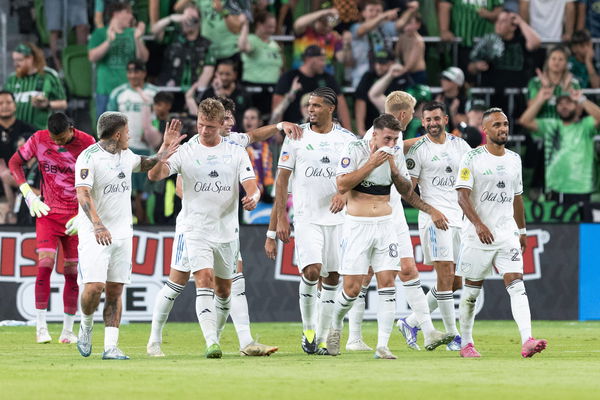
via Imago
Players of MLS, Fussball Herren, USA celebrate a goal during a in a friendly match between MLS All Stars and Liga MX All Stars at the Q2 stadium in Austin, United States, 23 July 2025. All-Star Game: MLS All Star vs. Stars Liga MX ACHTUNG: NUR REDAKTIONELLE NUTZUNG PUBLICATIONxINxGERxSUIxAUTxONLY Copyright: xCarlosxRamírezx AMDEP9079 0827044603st

via Imago
Players of MLS, Fussball Herren, USA celebrate a goal during a in a friendly match between MLS All Stars and Liga MX All Stars at the Q2 stadium in Austin, United States, 23 July 2025. All-Star Game: MLS All Star vs. Stars Liga MX ACHTUNG: NUR REDAKTIONELLE NUTZUNG PUBLICATIONxINxGERxSUIxAUTxONLY Copyright: xCarlosxRamírezx AMDEP9079 0827044603st
After its inception in 1990s, Major League Soccer has come a long way. Now, it’s the leading professional soccer league in the U.S. and Canada, with 30 teams playing across North America for the 2025 season—27 in the U.S. and three in Canada. After conquering its early financial challenges, the league is now celebrating its 30th season. And with this, MLS continues to thrive, thanks to soccer-specific stadiums, salary caps, and some big-name signings, which also helped in a significant rise in attendance and a growing global presence.
During its first ten years, MLS home teams really had a strong advantage, which was quite different from what we saw in the established European leagues. But that home-field advantage has faded a bit.
According to a report by the Guardian, in 2025, home teams won only about 44% of matches (down from a peak of 56% in 2017), roughly aligning MLS with Premier League norms, where home win rates hover around the mid‑40s. Instead of feeling sad about the loss of home-field magic, the league’s move toward parity shows that it’s becoming a more balanced and globally recognized competition. These days, playing at home doesn’t always mean an easy win. Away teams are now flying in on charter flights, following recovery routines based on circadian science, and using some pretty sharp tactical game plans.
ADVERTISEMENT
Article continues below this ad
These advancements tackle the issues that used to boost home advantage—like long travel distances, crossing multiple time zones, and playing in high-altitude venues—making away games a bit easier on teams. Teams are really stepping up their away game lately. They’re putting more money into sports science and careful planning to tackle the challenges they used to face on the road.
Refereeing in MLS has really matured over time. The introduction of VAR technology and improved referee training have really helped to lessen the home bias that used to influence those close calls in favor of the home teams. These days, home teams are getting fewer soft fouls or offsides called in their favor, which is bringing MLS refereeing more in line with international standards and reducing the advantage that comes from officiating at home. These days, away teams are moving away from those super-defensive strategies on road trips and are opting for more aggressive pressing systems instead.

Instead of parking the bus, clubs now deploy structured sequences to regain possession, control tempo, and exploit gaps. Matches that used to be influenced by unexpected set pieces or the energy of the crowd have now turned into more structured play, no matter where they take place. This alignment with Premier League metrics does a lot more than just adjust home-win percentages. It highlights how MLS is moving away from being a one-of-a-kind competition in terms of geography and logistics and instead focusing more on things like preparation, adaptability, and having a deep squad.
What’s your perspective on:
Is the fading home-field advantage a sign of MLS's growth or a loss of its identity?
Have an interesting take?
Home crowds still play a role, but they don’t automatically sway the outcome anymore. Success comes from being professional, having tactical discipline, and relying on performance backed by sports science—these are the key traits of well-established global leagues. MLS is moving away from its quirky early reputation and is starting to align more with the global standard—where results are based on merit rather than just geography. So, what do people who are directly involved in the MLS think about how things have changed over the years?
ADVERTISEMENT
Article continues below this ad
Top voices of MLS on the home ground advantage
Peter Vermes, the former head coach of Sporting Kansas City, once said, “Home-field advantage is everything.” He pointed out that it’s not just about the fans; it also involves long travel, different playing surfaces, and changes in routine that make away games tougher. He also pointed out that modern logistics, like charter flights, help lessen that advantage—implying that he recognizes the move away from just relying on home-court dominance.
On the flip side, LAFC coach Steve Cherundolo in late 2024 couldn’t help but rave about the home support, saying, “Our crowd is like nothing else I’ve seen live in LA, it’s pure passion, it’s electrifying and it really has the ability to make our players better.” That shows a belief in the power of the crowd, but it also goes against the wider trends in the league where that advantage is starting to fade.
ADVERTISEMENT
Article continues below this ad
Among players, there’s a growing acceptance of parity, even if it’s not often talked about. Olivier Giroud talked about how tiring the travel in MLS can be, saying, “Here, I’ve already done 20 hours of flight in a month. So it’s important to be even more professional in your recovery – sleeping well, eating well and doing the treatments you need to be fit.”
To sum it up, coaches like Vermes and Cherundolo definitely appreciate the support from home fans, but it’s pretty clear that the whole league is noticing some changes. Better travel logistics, recovery methods backed by sports science, smarter tactical planning, and VAR in officiating are all chipping away what used to be a huge home-field advantage. These days, teams and players are putting more emphasis on preparation and discipline instead of counting on the crowd’s energy to sway the outcome.
ADVERTISEMENT
ADVERTISEMENT
ADVERTISEMENT
ADVERTISEMENT


Is the fading home-field advantage a sign of MLS's growth or a loss of its identity?